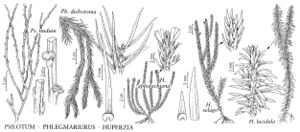Huperzia lucidula
Atti Soc. Ital. Sci. Nat. 17: 248. 1875.
Shoots erect, indeterminate, 14–20 (–100) cm, becoming long-decumbent, with long, trailing, senescent portion turning brown; juvenile and mature portions similar with strong annual constrictions due to formation of winter bud; juvenile growth erect. Leaves spreading to reflexed, dark green, lustrous; largest leaves narrowly obovate, leaves broadest at or above middle, 7–11 mm, margins papillate, teeth 1–8, irregular, large; smallest leaves (at annual constrictions) narrowly lanceolate, 3–6 mm; stomates on abaxial surface only. Gemmiferous branchlets produced in 1 pseudowhorl at end of each annual growth cycle; gemmae 4–6 × 3–6 mm, lateral leaves 1.5–2.5 mm wide, broadly obtuse with distinct mucro. Spores 23–29 µm. 2n = 134.
Habitat: Terrestrial in shaded conifer forests and mixed hardwoods, rarely on rock on shady mossy acidic sandstone
Elevation: 0–1800 m
Distribution

St. Pierre and Miquelon, Man., N.B., Nfld. and Labr. (Nfld.), N.S., Ont., P.E.I., Que., Ala., Ark., Conn., Del., Ga., Ill., Ind., Iowa, Ky., Maine, Md., Mass., Mich., Minn., Mo., N.H., N.J., N.Y., N.C., Ohio, Pa., R.I., S.C., Tenn., Vt., Va., W.Va., Wis.
Discussion
Huperzia × bartleyi (Cusick) Kartesz & Gandhi, a sterile hybrid between H. lucidula and H. porophila, occurs throughout the range of H. porophila and is discussed under that species. Huperzia × buttersii (Abbe) Kartesz & Gandhi is a hybrid between H. lucidula and H. selago.
Selected References
None.
Lower Taxa
"above middle leaves" is not a number.
